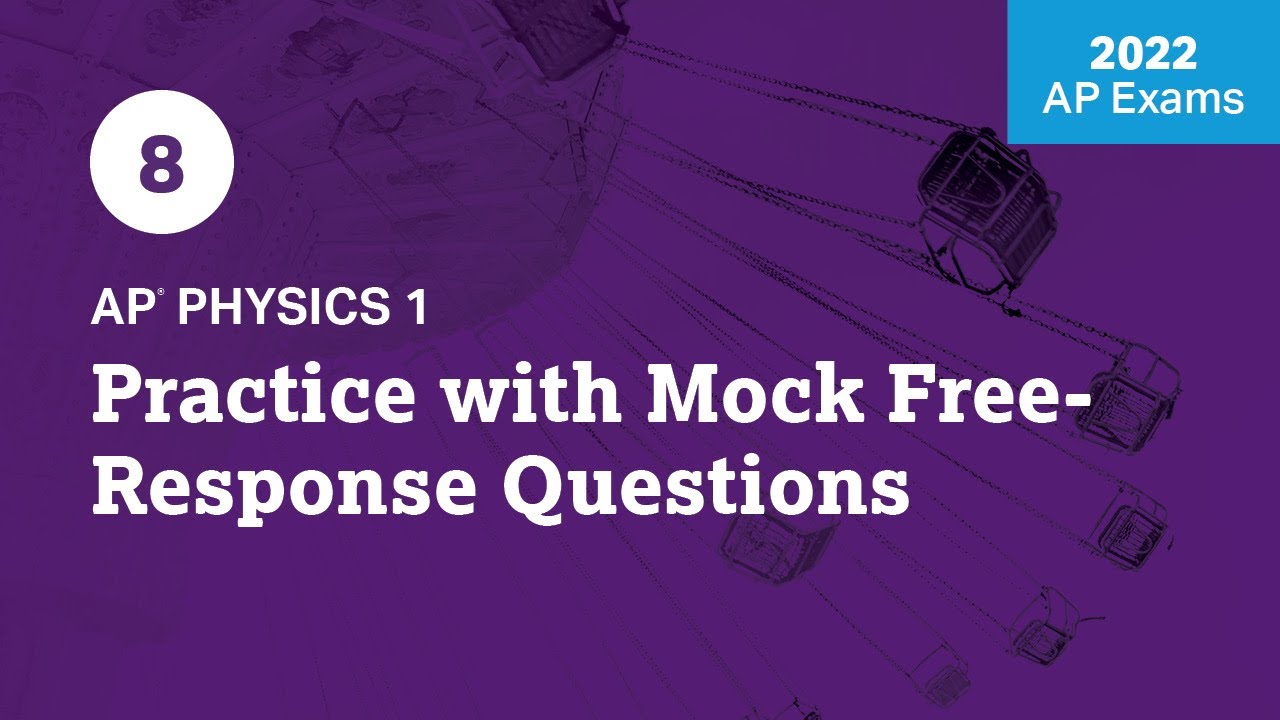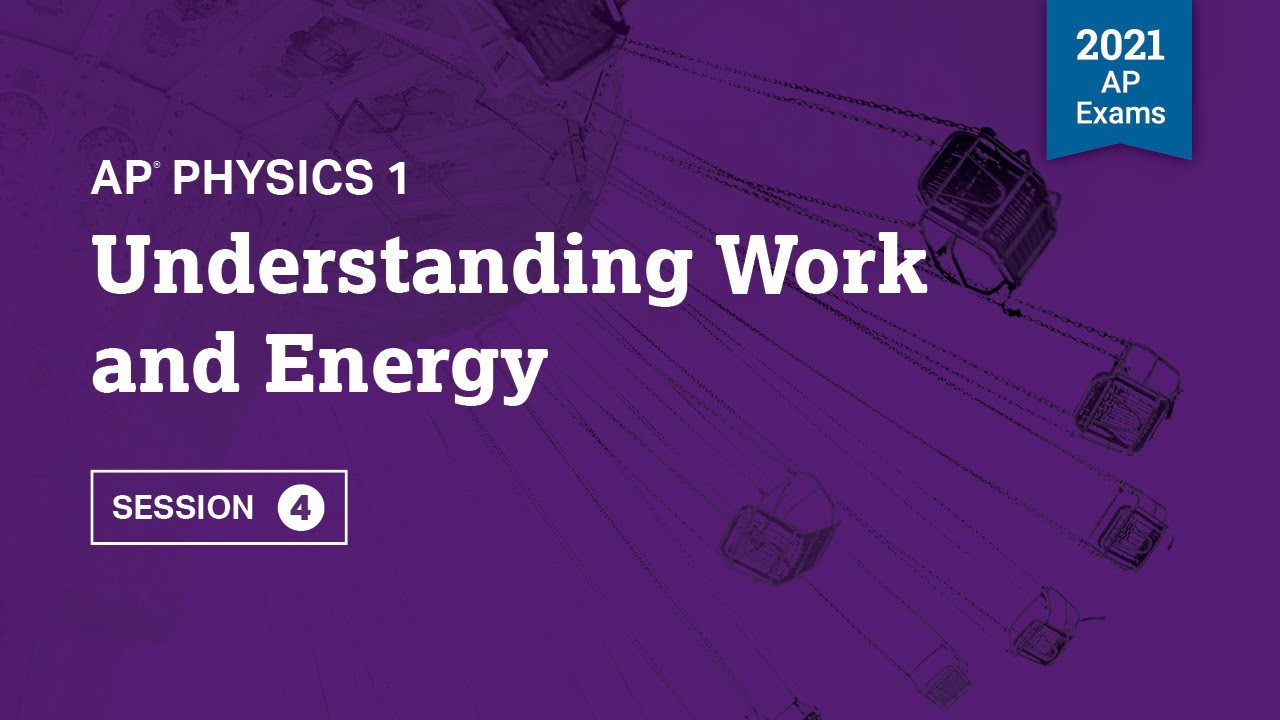2 | FRQ (Question 4/5: Short Answer) | Practice Sessions | AP Physics 1
TLDRIn this AP Physics 1 practice session, Kristin Gonzalez-Vega guides students through solving free response questions. She focuses on strategies for tackling different types of questions, using a 2020 exam question as an example. The session covers calculating the spring constant from a motion graph, explaining energy conservation through graph analysis, and determining equilibrium positions with a new spring constant. Gonzalez-Vega emphasizes the importance of showing work, using formulas correctly, and understanding the system's dynamics for accurate problem-solving.
Takeaways
- 📚 The session is an AP Physics 1 practice focusing on free response questions (FRQs).
- 🎯 Different types of FRQs are present on the AP exam, with five questions in total: three shorter 7-point questions and two longer 12-point questions.
- 📈 For part A of the question, use the period equation (2π√(m/k)) to calculate the spring constant from the graph provided.
- 🔢 The spring constant is determined to be 12.6 N/m by using the given mass (0.5 kg) and period (1.25 s) from the graph.
- 📝 Show all work and include units in numerical answers to ensure clarity and correctness.
- 🏆 Partial credit is given for showing understanding and applying correct physics concepts, even if a mistake is made in a previous part.
- 🌟 The system in the experiment includes the object, the spring, and the Earth, and is subject to conservation of mechanical energy.
- 🔄 The total kinetic and potential energies of the system remain the same at different times, as indicated by the graph's features.
- 📐 When the spring constant is quadrupled (4k), the new equilibrium position is calculated to be 0.9 meters above the motion detector.
- 📊 For part C II, sketch a graph representing the object's motion, label the vertical axis with an appropriate numerical scale, and ensure the graph has the same amplitude and is centered on the new equilibrium position.
Q & A
What is the main focus of the video?
-The main focus of the video is to provide strategies for answering free response questions in the AP Physics 1 exam, specifically by discussing the different types of questions and how to approach them.
How many free response questions are there on the AP Physics 1 exam?
-There are five free response questions on the AP Physics 1 exam.
What are the two types of free response questions mentioned in the video?
-The two types of free response questions mentioned are shorter answer seven-point questions and longer 12-point questions.
How does the video suggest students prepare for the free response sections?
-The video suggests that students prepare by downloading the practice questions as PDFs, getting out paper, a formula chart, and a calculator to work along with the video.
What is the scenario described in the free response question from the 2020 exam?
-The scenario involves a spring hanging from the ceiling with an unknown spring constant and a mass of 0.5 kilograms hung from it. The mass is allowed to oscillate up and down, and the height from a motion detector is recorded as a function of time.
How is the spring constant calculated in the video example?
-The spring constant is calculated using the period equation (2π√(m/k)), where the mass (m) is known, and the period (T) is obtained from the graph.
What is the significance of the system in the context of the video?
-In the context of the video, the system includes the object, the spring, and the Earth. The video emphasizes that no external forces are acting on the system, meaning the total mechanical energy remains constant.
How does the video explain the conservation of mechanical energy in the system?
-The video explains that since no external forces are acting on the system, the total mechanical energy, which is the sum of kinetic and potential energy, remains constant. This is used to explain why the total kinetic and potential energies are the same at certain times during the oscillation.
What happens when the experiment is repeated with a spring constant of 4k?
-When the experiment is repeated with a spring constant of 4k, the new equilibrium position of the mass is determined to be 0.9 meters above the motion detector, and the period of oscillation changes.
How is the new equilibrium position found in the video?
-The new equilibrium position is found by using Hooke's law (F = kx) and considering that the new spring constant is four times greater than the original, which means the stretch is only a quarter of the original, resulting in a new equilibrium position of 0.9 meters above the motion detector.
What is the importance of labeling the vertical axis correctly in part c ii of the video?
-Labeling the vertical axis correctly in part c ii is important because it provides the appropriate numerical scale for the graph representing the motion of the object. This is essential for accurately plotting the points and understanding the amplitude and period of the oscillation.
How does the video address the concept of consistency in the AP exam?
-The video explains that even if a student makes a mistake in one part of the exam, they can still earn points for good physics in subsequent parts if their work is consistent with their stated assumptions. This encourages students to persist and continue working through the problems.
Outlines
📚 Introduction to AP Physics 1 FRQ Practice
Kristin Gonzalez-Vega introduces the video series focused on AP Physics 1 free response questions (FRQs). She explains the structure of the upcoming videos, which will cover strategies for answering different types of FRQs, including the shorter 7-point questions and longer 12-point questions. The session specifically focuses on question 5 from the 2020 AP exam, which involves a spring with an unknown constant, a mass, and a motion detector. The goal is to calculate the spring constant using the period equation and to understand the different approaches to solving such problems. The importance of showing all work and using the correct formulas is emphasized, as well as the need to download the questions as PDF and prepare paper, a formula chart, and a calculator for active participation.
🔍 Analyzing the Spring Constant Calculation
The video segment delves into the process of calculating the spring constant (k) from the given data and graph. Two methods are discussed: using the period equation (2π√(m/k)) and Hooke's law (mg = kx). The first method involves using the period of oscillation from the graph and the known mass to solve for k. The second method uses the change in equilibrium position due to the mass hung on the spring. The importance of showing all steps and maintaining units is highlighted. The video also explains how to earn points on the AP exam by demonstrating a clear understanding of the concepts and correctly applying them to the problem.
📊 Interpreting the Graph for Energy Conservation
This part of the script focuses on analyzing the provided graph to understand the conservation of energy in the object-spring-Earth system at two different times. The key is to recognize that the total mechanical energy remains constant when no external forces are acting on the system. The explanation involves comparing the kinetic energy at the two times, which is determined by the slope of the graph (indicating speed). The potential energy is then discussed, emphasizing that since the total energy is conserved and the kinetic energy is the same at both times, the potential energy must also be the same. The video encourages the use of the graph to support the explanation and to understand the significance of the system's boundaries and the conservation laws in physics.
🔄 Predicting the New Equilibrium Position and Motion
The script outlines the steps to predict the new equilibrium position when a spring with a spring constant of 4k is used, and the object is the same 0.5 kg mass. The focus is on applying Hooke's law and understanding the relationship between the spring constant and the stretch of the spring. The new equilibrium position is calculated to be 0.9 meters above the motion detector. The video then discusses the process of drawing the motion curve for the object on a graph, including determining the period, amplitude, and starting position. The importance of labeling the vertical axis with the correct numerical scale and ensuring the graph is consistent with the given information is emphasized.
🎓 Conclusion and Encouragement for Future Practice
In the concluding segment, Kristin Gonzalez-Vega summarizes the key points covered in the video and encourages students to continue practicing free response questions. She highlights the importance of understanding the concepts and applying them correctly, even if a mistake is made in one part of the problem. The video emphasizes the AP exam's approach to grading, which rewards good physics understanding and consistency, even in the face of errors. Students are encouraged to persist and continue practicing, ensuring they understand the material and can apply it effectively.
Mindmap
Keywords
💡AP Physics 1
💡Free Response Questions (FRQs)
💡Spring Constant (k)
💡Hooke's Law
💡Simple Harmonic Motion
💡Period (T)
💡Equilibrium Position
💡Kinetic Energy (K)
💡Potential Energy (U)
💡Mechanical Energy Conservation
💡Graph Analysis
Highlights
Introduction to AP Physics 1 practice sessions by Kristin Gonzalez-Vega, a teacher at Centennial High School in Frisco, Texas.
Focus on Free Response Questions (FRQs) and strategies for answering them in the AP Physics 1 exam.
Explanation of the different types of FRQs: shorter answer seven-point questions and longer 12-point questions.
Use of a spring and mass system to demonstrate oscillation and simple harmonic motion.
Method to calculate the spring constant using the period equation and data from a motion detector graph.
Emphasis on showing all work and including units for numerical answers in exam responses.
Alternative method to find the spring constant using Hooke's law and the change in equilibrium position.
Explanation of how to obtain points on the exam by demonstrating understanding of physics concepts and showing work.
Analysis of the system's total kinetic and potential energy at different times using the motion detector graph.
Importance of identifying the system's components and external forces in understanding energy conservation.
Experiment repetition with a spring constant of 4k and its impact on the new equilibrium position.
Determination of the new equilibrium position using Hooke's law and the concept of stretching the spring.
Instructions on how to draw and label a graph representing the motion of the object for a given scenario.
Explanation of how the period of oscillation changes with the spring constant and its impact on the graph.
Guidance on plotting the graph with the correct amplitude, period, and equilibrium position for the scenario.
Encouragement to persist and continue working through practice questions even if stuck on a particular part.
Transcripts
Browse More Related Video

1 | MCQ | Practice Sessions | AP Physics 1

3 | FRQ (Question 1: Experimental Design) | Practice Sessions | AP Physics 1

2022 Live Review 8 | AP Physics 1 | Practice with Mock Free-Response Questions

6 | FRQ | Practice Sessions | AP Physics C: Mechanics

2021 Live Review 4 | AP Physics 1 | Understanding Work and Energy

8 | FRQ (with Experimental or Lab-Based Component) | Practice Sessions | AP Physics C: Mechanics
5.0 / 5 (0 votes)
Thanks for rating: